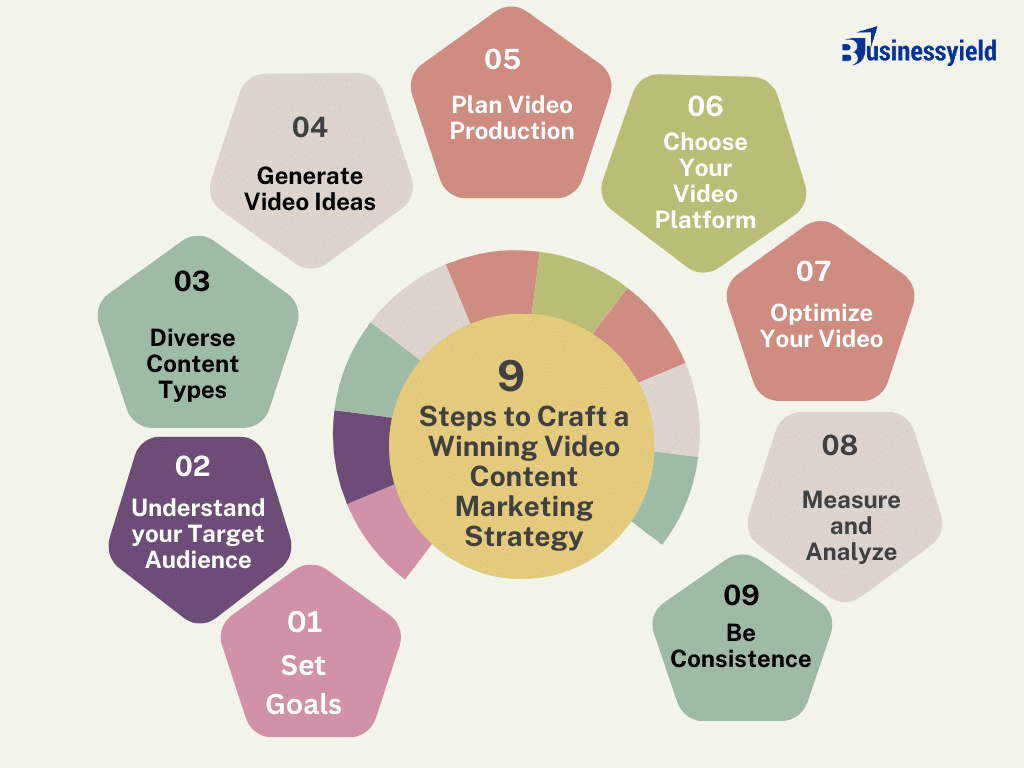Ever stumbled upon a video so enthralling that you forgot to breathe for a whole minute? (Guilty as charged!) That’s the magic of video content. But let’s face it: diving into crafting your video masterpiece often feels like trekking through a content jungle, where vines of doubt and confusion relentlessly snag at your ankles. Fear not! I will not only show you some stats but will also guide you through crafting an unparalleled video content marketing strategy that not only resonates with your audience but boosts your overall marketing campaign, thus increasing profits.
Key Takeaways
- A video content strategy is your roadmap to victory. It defines what you want to achieve, who you’re aiming for, what kind of videos will resonate, and where you’ll unleash them. Think of it as your secret weapon before hitting the “record” button.
- Set SMART goals: Make your objectives clear, measurable, and achievable. Track your progress and celebrate those wins!
- Know Your Audience: Think of your audience like your best friends. Know their interests, their struggles, and what makes them tick. This way, you can tailor videos that speak directly to them, sparking their curiosity and keeping them hooked.
- Different Types of Content: Use a range of video types, such as tutorials, vlogs, animations, and reviews. Stay flexible as trends change, such as the rise in popularity of short films on Instagram and TikTok.
- Production Planning: Make a thorough plan for making the video that includes the format, script, budget, crew, and technical details. A well-organized production plan makes the process of making a movie go smoothly.
What is a Video Content Creation Strategy?
Video content is omnipresent, and its reign is far from over. It’s flourishing! Short-form videos, live streams—you name it. A video content creation strategy is more than just a list of steps. It’s a well-thought-out journey that includes goals, target audience, content types, distribution channels, and the general way of making and sharing videos. A video content creation strategy is a systematic and organized framework that ensures your videos align with broader business or individual objectives.
In simpler terms, a video content strategy is the amalgamation of knowledge, goals, ideas, and resources in one place. It also involves planning, creation, distribution, and monitoring, encompassing colors, tone, branding elements, and ways to enhance the viewer experience.
Therefore, crafting a winning video content creation strategy in 2024 is all about diving deep into trends, embracing fresh ideas, and leveraging the AI advantage. According to SocialPilot, video content will make up 82% of the internet traffic in 2024. So, the time to build a winning video content strategy is now. Let’s dive in.
You might also like to read Video Editing Apps for Beginners: Detailed Guide for Beginners
Steps to Craft a Winning Video Content Marketing Strategy
Video marketing is the fastest-growing type of marketing in digital advertising (SocialPilot), so it is crucial to craft a winning video marketing strategy that will boost sales and other set metrics. The following are some of the best steps to take:

#1. Set Goals for Your Video Content
Before embarking on creating video content, clarity on why you’re creating it is crucial. Concrete objectives will guide every step of your video-making adventure. Set SMART goals:
- Specific: Pinpoint precisely what you aim to achieve with each video.
- Measurable: Quantify your goals to track progress and success.
- Achievable: Set realistic goals to avoid morale and budget disasters. For example, you can set a goal to drive $5,000 in sales directly from video ads within 2 months.
- Relevant: Align video goals with overall marketing objectives and brand strategy. For example, a relevant goal can be to increase product knowledge survey scores by 10% after viewing product videos.
- Time-bound: Set deadlines to create urgency and measure progress, like publishing 2 engaging videos per week for the next quarter, and so on.
Back in my early video-making days, a lack of clear goals made my content scattered. Defining specific objectives focused on my content led to a noticeable uptick in engagement.
#2. Understand your Target Audience and their Needs
To craft a compelling video content marketing strategy in 2024, you must have a deep understanding of your audience’s demographics, preferences, and behaviors. Furthermore, you should research, analyze, and understand their pain points and passions. Craft content that resonates, evoking laughter, tears, or a triumphant “Finally, someone gets me!” Poll your audience on content preferences, a strategy that helped me aggregate the types of video content my audience desired.
#3. Embrace Diverse Content Types
Determine the types of videos to create, from tutorials and vlogs to animations and customer testimonials. Align content types with objectives and audience preferences. Carry out research, find what goes best with your brand, and create a list of video types that serve your goals and objectives. When creating marketing video content for your brand, you can choose from a variety of content types, ranging from vlogs and tutorials to BTS.
If you have not noticed, short-form videos on TikTok and Instagram are very popular in 2024, However, don’t limit yourself by sticking to just one format; try others like live streams, BTS, explainer videos, etc.
Types of Video Contents
#1. Interviews
Interviews are talks with experts, influential people, or important people in the field. Additionally, it helps people trust you by giving them information, advice, and proof of your trustworthiness, thus establishing credibility.
#2. Brand Stories
The narratives that encapsulate a brand’s essence, values, mission, and history are called brand stories. Furthermore, they frequently draw attention to the unique qualities of the company and elicit strong feelings from the viewer. According to recent video content marketing stats. by Wyzowl, 89% of consumers want to see more videos from brands in 2024.
#3. Product Reviews
These are assessments of goods or services made by people or businesses. They further provide an unbiased assessment, emphasize features, advantages, and disadvantages, and assist prospective buyers in making smart choices.
#4. Customer Testimonials
Recent video content marketing stats. by Wyzowl shows that 39% of video marketers have created video testimonials. Testimonials provide actual user experiences with a product or service, fostering credibility and confidence among potential customers. These are simply honest endorsements. In essence, testimonials boost buyer trust by sharing real-life experiences.
Social media snippets are brief, visually striking videos created specifically for Twitter, Instagram, or TikTok. Their goal is to instantly pique the interest of the audience and promote participation or sharing. In essence, snippets help grab viewers’ attention instantly and encourage sharing.
All things considered, these kinds of video content have a variety of uses in marketing strategies, ranging from brand promotion and storytelling to audience education, engagement, and persuasion.
#4. Generate Video Ideas
With your audience and goals locked in, it’s time to ignite your video content furnace! Unleash your creativity with brainstorming tools like mind maps, word lists, or even online platforms. What kind of video would captivate your target audience? Then what knowledge gap can you fill? What emotion can you evoke? Remember, your content should resonate with their needs and interests.
#5. Plan Video Production
Ideas secured? Now let’s build! From format and script to budget and crew, your production plan is the foundation. Consider technical aspects like resolution, sound, and lighting. A detailed roadmap with tasks and timelines will keep your video journey smooth.
Stages of Video Content Production
- Pre-production
This phase entails preparation and planning. Therefore, it entails activities including coming up with concepts for videos, writing scripts, creating storyboards, casting, looking for locations, and planning logistics like crew and equipment.
- Production
The actual filming phase is when the planned material is recorded. It further entails doing things like assembling the appropriate equipment, conducting (if any) interviews, filming sequences, and taking the required footage following the storyboard and script.
- Post-production
The video is edited and polished at this stage, following the filming process. Work like color grading, sound editing, visual effects, video editing, and adding any required graphics or animations are also included in this step. Finally, the video is completed and prepared for release.
#6. Choose Your Video Platform
Where will your videos call home? YouTube, Instagram Reels, TikTok, or your website? Understanding platform strengths and audience demographics aids in making the right choice. Crucial questions to ponder:
- Who is your target audience?
- Which platforms match your target audience demographics?
- Is your audience active on multiple platforms?
- What type of video content are you creating?
- Which platforms suit your content format?
- Do platforms offer features that support your content goals?
- What is the potential reach of each platform?
Your video content strategy must answer these questions to choose the ideal distribution platform.
What Are the Best Platforms for Your Video Content?
Recent video content marketing stats. according to Wyzowl, YouTube remains the most successful video marketing platform for marketers, with 78% reporting it to be effective. However, no platform is “best.” To maximize your video’s impact, experiment, evaluate data, and customize content to each platform’s capabilities and audience preferences.
The following structure is versatile, so many videos fit many categories. Understanding your target audience and platform preferences helps you determine the optimal video format and distribution plan.
By Platform
- Short-form & Trendy: TikTok, Instagram Reels, YouTube Shorts
- Mid-form & Diverse: Instagram video, Facebook video, LinkedIn video
- Long-form & Professional: YouTube, Twitch (VODs), Vimeo
By Length
- Short-form (under 3 minutes): TikTok, Instagram Reels, YouTube Shorts
- Mid-form (3–10 minutes): Instagram video, Facebook video, LinkedIn video
- Long-form (10+ minutes): YouTube, Twitch (VODs), Vimeo
Other Categories
- Industry-Specific Platforms: Twitch for games, YouTube for music
- Niche platforms: (cooking tutorials on Tasty, Pinterest for DIY projects)
ALSO READ: BEST TIME TO POST ON YOUTUBE SHORTS: Mastering YouTube Shorts
#7. Optimize Your Video for Maximum Audience Engagement
In the digital landscape, there are thousands of videos vying for attention. So, how will you attract your target audience to your video content, rank highly on search engines, and make your video go viral? You achieve the above by staying on top of trends, carrying out competitor analysis, and, most importantly, listening to your audience.
AI tools can also lend a hand, suggesting fresh concepts and unexpected twists. While views are cool, engagement is where the magic happens. Therefore, encourage comments, respond to your audience, and include a clear call to action. Furthermore, ensure to incorporate a distinct call to action. Experienced digital marketers understand the significance of a clear call to action aligned with goals, whether generating leads, increasing sales, or sparking a conversation. Engagement turns your videos into discussion hubs.
If you conduct live videos, also take advantage of instant notifications for comments and make it a priority to acknowledge and value their opinions.
#8. Measure and Analyze your video content
To carry out video marketing campaigns in 2024, tracking your metrics is a must. You must not only track who watches your content but also how they engage with it and what other actions they take, such as commenting and sharing. Track your content views, likes, and comments, and also understand what categories of content your audience interacts with more. Fear not the analytics; they’re your map, guiding you to your audience and refining your content strategy.
In 2024, essential video content marketing metrics also comprise watch time, view count, engagement, click-through rate, and conversion rate. Utilize tools like YouTube Analytics and Google Analytics for effective tracking.
#9. Post Consistency
Posting consistency can lead to video content marketing success. You must ensure that you create your content, generate good captions and hashtags ahead of the posting date, set a posting schedule, and maintain a cohesive visual style. Consistency further builds trust and informs your audience when to return for more.
Lack of consistency is a major reason businesses falter in video marketing. Define your consistency level by outlining the number of videos per week or month, video types, distribution channels, and promotion techniques. Quality should never be compromised for quantity.
Video Content Marketing Stats.
The following are some of the recent stats. on video content marketing in 2024:
- 90% of marketers say video marketing has given them a good ROI. (Wyzowl)
- 91% of businesses use video as a marketing tool (Wyzowl)
- According to Statista, the amount spent on video marketing will reach $92.253 billion in 2024.
- Videos on social media get 12 times more shared than text and images combined. (SocialPilot)
- 88% of marketers say video is an important part of their marketing strategy. (Wyzowl)
- 75% of video marketers say they’ve used AI tools to help them create or edit marketing videos. (Wyzowl)
- Over 80% of marketers are now using video content in their marketing strategies, demonstrating its widespread adoption (Wyzowl)
Benefits of Crafting Good Video Content Marketing Strategy
#1. Increased Brand Engagement
Crafting a video content strategy helps you create compelling videos that tell your story, boost recognition, and create positive associations. Videos grab attention better than text or images, building stronger connections and loyalty. Sharing across platforms widens its reach. So, in 2024, crafting more video content can increase your brand’s engagement, as video content is in demand right now.
#2. Leads & Sales
According to Wyzowl, 87% say that video marketing has helped them generate leads. Therefore, when you craft a compelling video content strategy for your marketing campaigns, clear calls to action and interactive elements can motivate users to carry out certain actions and, hence, drive conversions. Demonstrations build trust and raise conversion rates.
#3. SEO
Search engines love video content, and transcripts and keywords improve organic reach. In addition, backlinks from video embeds further strengthen SEO. When you craft a good video content strategy, you can optimize your videos and keywords to increase search engine visibility and rank highly.
#4. ROI
A well-planned video content strategy offers more measurable results. your brand can measure the various metrics set in its strategy. Trackable results, cost-effectiveness compared to traditional methods and long-term brand equity lead to higher profitability.
#5. Stay Ahead
The internet is ever-changing. Stay informed about emerging trends, whether in platforms or video formats. Being an early adopter can give you a significant advantage. Jumping on a new trend early once landed me on the ‘For You’ page, showcasing the wonders trend surfing can do for your visibility.
What is Video Content Creation?
Video content creation means planning, making, and sharing videos on different platforms and formats to get a point across, entertain viewers, or keep them interested.
What are Content Creation Strategies?
Planning, making, and sharing content in a way that meets certain goals is part of content creation methods. They include setting goals, figuring out who the audience is, picking platforms and content types, making sure the platform is engaging, and tracking success.
Who is a Content Creator?
A content creator is a person or organization that makes unique, often multimedia, content and shares it on different platforms, showing their creativity, expertise, and interesting content to a specific audience.
What Are the Steps to Create a Video Content Strategy?
Define goals, understand the target audience, choose content types, select distribution platforms, optimize content, measure performance, be consistent, and adapt to trends.
Get Started NOW
In summary, content strategy is set in stone. Regularly assess your video performance against your goals and also use analytics insights to tweak your strategy. It’s all about continuous improvement. The continuous success of your marketing campaigns depends on the framework you create now.
So, what are you waiting for? Grab your camera, light, and action! Start creating video content that connects, inspires, and drives results. The future is bright, and it’s filled with engaging stories waiting to be told. Let your video be the one that captures hearts and minds.
- What Is SEM? Your Crash Course On Search Engine Marketing And Why It Matters
- The Ultimate 2024 Social Media Strategy Playbook: Master Every Platform, Conquer Every Target Audience
- The Definitive Guide To 2024’s Content Marketing Strategies: Master The Art, Crush The Competition
- The Top 8 Best Affiliate Marketing Platforms and Network in 2024
- Top Secrets You Need to Rank Higher with YouTube SEO






